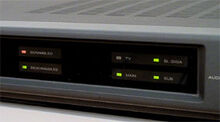
The Satellaview's set-top box. The BS Tuner (BSチューナー).
A Set-Top Box is a hardware component that allows for an expansion of signal recognition in a television set by the conversion of previously unrecognized signals into the television's native signal range.

The back of the St.GIGA's tuner.
History[]
The Set-Top Box was developed in the 1950s to circumvent channel-based restrictions imposed on radio signaling (transmission/reception) devices by the government. According to government regulations, the the range of radio frequencies involved in radio and television transmission (VHF - 30 to 300 MHz) are often divided between public use (the so-called "citizen's band" or "CB"), commercial use, military use, and other more minor uses. Television sets have traditionally only been attuned to the commercial band.
As public consumption of commercial channels in the 1950s outstripped the wavelength allocations for the commercial channels, the growing television industry turned to alternative broadcasting strategies including a shift to UHF (300 MHz to 3 GHz). Transmissions within this range would not be picked up by TVs of the time so the Set-Top Box was invented to receive UHF signals and convert them into VHF that could be recognized by the TV set.
The concept of a device that could receive non-native signals and convert them into the vernacular of a specific TV set was not limited to UHF to VHF converters and soon the same theory was applied to a variety of other signals. As TV sets began to be shipped with UHF-reception technology in-built, Set-Top Boxes became used for such purposes as converting Satellite signals into VHF/UHF for Television sets. Set-Top Boxes also saw an expansion of function as they began to be used by commercial broadcasters as a decryption device. Scrambled signals for pay-only channels could be broadcast to the world at large and only those civilians who had rented/purchased licensed decryption Set-Top Boxes could decode and view the program.
Use in the Satellaview[]
The Satellaview's Set-Top Box, also called the "BS tuner" was designed to receive scrambled radio signals from St.GIGA's BSAT-3a satellite that were broadcast within the BS-5ch band. The BS Tuner functioned to unscramble the signal and to split the decoded output into audio/video and bitstream data components that would be fed directly to the AV Selector which then connected the Satellaview to the Television set. Although some audio/video elements were encoded in the form of bitstream data that formed the content of the broadcast game/magazine, the majority of the audio (e.g. enhanced orchestral musical scores and all SoundLink vocal files) as well as a portion of the video (e.g. intro and cut scene portions) were passed directly from the BS Tuner to the AV Selector and thence to the television without interaction from the Satellaview. This is the reason that Satellaview games that have been recovered today usually lack then enhanced audio and introductory animated scenes that characterized Satellaview games.
The fact that audio/video data could pass directly to the television without concern for memory-space on the Satellaview meant that game content could be much larger and more complex than equivalent games for other systems of the time. The portion of the game that was saved to the 8M Memory Pack and the Satellaview's internal space, however, was much more basic and consisted of just the game engine and in-game images and sounds. This means that the final act of integrating the Satellaview's expanded audio/visual components with the basic dumped ROM to reproduce the game as broadcast has fallen on the shoulders of hackers in the fan community. Non-memory-pack source material is scarce, consisting mainly of VHS recordings and audio recordings of original gameplay. The audio recording quality is often quite poor as well. Further difficulties arise for hackers wishing to make reproduction carts as the space requirements needed to hold high-quality orchestral scores and complex animated intro scenes often exceed the limits imposed on the original carts and require hardware workarounds.

The Satellaview's Set-Top Box was not a Nintendo product and it did not come with the Satellaview bundle. Instead, the BS Tuner was a hardware component that was licensed by St.GIGA as a means to receive and decrypt their radio broadcasts prior to their involvement with Nintendo. Satellaview owners who were already subscribers to St.GIGA, previously an ambient-music-only station, could use the same BS Tuner they used to receive St.GIGA's signals. Due to the relative popularity of St.GIGA prior to 1995, a good percentage of new users already possessed a BS Tuner prior to their purchase of a Satellaview, however for those that did not already subscribe to St.GIGA, a rental option was introduced to allow Satellaview owners to gain access to the required BS Tuner. Whereas the purchase of a BS Tuner ran around ¥33,000, the 6-month rental price was merely ¥5,400.[1] The need for a Set-Top Box contributed to the already relatively high price of the Satellaview.
References[]
- ↑ セント・ギガ ギャラリー ● デコーダー St.GIGA.jp. Retrieved 22 November 2010.